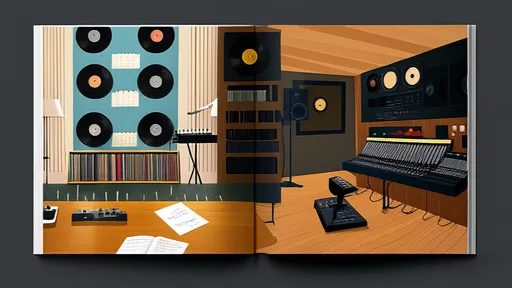In the relentless pace of modern life, the quest for inner peace has become more pressing than ever. Amidst the cacophony of daily responsibilities, digital notifications, and societal pressures, the mind often yearns for a sanctuary—a quiet space to reset and rejuvenate. While traditional meditation practices have long been revered for their calming effects, a growing number of individuals are turning to a more accessible and immersive alternative: musical meditation. This practice leverages specific frequencies and rhythms to guide the mind into a state of deep tranquility, offering a unique pathway to serenity that resonates with both novices and seasoned meditators alike.
The concept of using sound for healing and relaxation is not new; it dates back thousands of years across various cultures. From the chanting of monks in Tibetan monasteries to the rhythmic drumming of indigenous ceremonies, sound has always been recognized as a powerful tool for altering consciousness. However, in recent decades, scientific research has begun to validate what ancient traditions have long espoused: that certain auditory stimuli can profoundly influence our mental and emotional states. Musical meditation builds on this foundation, combining elements of neuroscience, psychology, and artistry to create experiences that are both therapeutic and transformative.
At the heart of musical meditation are specific frequencies believed to synchronize with the brain's natural waves. One of the most well-known is the 432 Hz frequency, often dubbed the "miracle tone" or "universal frequency." Proponents argue that music tuned to 432 Hz resonates more harmoniously with the human body and the natural world, promoting feelings of peace and well-being. In contrast, the standard tuning of 440 Hz, which dominates modern music, is said to create a sense of tension and disconnection. While empirical evidence on this specific frequency is still emerging, many users report significant reductions in anxiety and stress when listening to 432 Hz compositions. The gentle, warm quality of this tuning seems to cradle the listener in a cocoon of sound, making it easier to let go of intrusive thoughts and embrace the present moment.
Another powerful element in musical meditation is the use of binaural beats. This technique involves playing two slightly different frequencies in each ear, prompting the brain to perceive a third, rhythmic beat that can guide brainwave activity. For instance, if a tone of 300 Hz is played in the left ear and 310 Hz in the right, the brain will interpret a 10 Hz binaural beat, which corresponds to the alpha brainwave state associated with relaxation and light meditation. By carefully selecting these frequencies, practitioners can induce states ranging from deep sleep (delta waves) to heightened focus (beta waves). This auditory illusion acts as a subtle yet effective metronome for the mind, helping to steer it away from chaos and toward calmness without any conscious effort.
Rhythm, too, plays a crucial role in this practice. Unlike the erratic beats of pop or rock music, which can overstimulate the nervous system, the rhythms used in musical meditation are often slow, steady, and repetitive. Think of the gentle pulse of a heartbeat or the soothing cadence of ocean waves—these natural rhythms have an innate ability to calm the human psyche. In musical meditation, compositions might incorporate drumming at a pace of 60 beats per minute to mimic a resting heart rate, or use ambient sounds like rainfall or wind chimes to create a seamless flow that lulls the listener into a meditative state. This rhythmic consistency provides a stable anchor for the mind, preventing it from wandering into anxiety or distraction.
But how does one actually practice musical meditation? The process is beautifully simple and highly adaptable. It begins with finding a quiet, comfortable space where you won't be disturbed. Using headphones can enhance the experience, especially for techniques like binaural beats that rely on stereo sound. Next, select a piece of music designed for meditation—this could be a track with solfeggio frequencies, ambient nature sounds, or a guided meditation set to a soft musical backdrop. As the music plays, focus on your breath, allowing the sounds to wash over you without judgment or analysis. The goal isn't to empty the mind completely, but to let the music guide your attention, gently pulling you back whenever thoughts arise. Sessions can last anywhere from five minutes to an hour, depending on your schedule and needs.
The benefits of this practice are both immediate and cumulative. In the short term, musical meditation can lower cortisol levels, reduce blood pressure, and alleviate symptoms of stress. Many users describe feeling a weight lift from their shoulders within minutes of starting a session, as if the music is physically untangling knots of tension. Over time, regular practice can rewire neural pathways, making it easier to access states of calm even outside of meditation. This neuroplasticity effect means that the more you engage with these frequencies and rhythms, the more naturally your brain will gravitate toward peacefulness in everyday life. It's like building a mental muscle for tranquility.
Moreover, musical meditation is incredibly inclusive. For those who struggle with the silence of traditional meditation—finding it boring or frustrating—the addition of music provides a engaging focal point. It also appeals to people with busy minds, such as artists, entrepreneurs, or students, who might benefit from a practice that doesn't demand absolute stillness but instead works with their natural cognitive rhythms. Parents use it to calm restless children, therapists incorporate it into treatment for anxiety disorders, and offices are beginning to introduce sound baths during lunch breaks to boost employee well-being. The versatility of musical meditation makes it a valuable tool for virtually anyone seeking respite from the noise of modern existence.
As with any wellness practice, the key to success with musical meditation is consistency and intentionality. It's not enough to simply play calming music in the background while scrolling through your phone; the magic happens when you actively engage with the sound, using it as a vehicle for introspection and release. Experiment with different genres and frequencies to discover what resonates most deeply with you. Some may find solace in the ethereal tones of crystal singing bowls, while others prefer the earthy drums of shamanic music. There is no one-size-fits-all approach, which is part of what makes this journey so personal and rewarding.
In a world that often feels fragmented and overwhelming, musical meditation offers a harmonious antidote. By harnessing the ancient power of sound and rhythm, we can tune our minds to frequencies of peace, creating an inner sanctuary that remains accessible no matter what challenges arise externally. This practice reminds us that tranquility isn't something we need to seek outside ourselves—it's a state we can cultivate from within, with the right tools and a willingness to listen. So put on your headphones, close your eyes, and let the music guide you home to yourself.

By /Aug 22, 2025

By /Aug 22, 2025

By /Aug 22, 2025

By /Aug 22, 2025

By /Aug 22, 2025

By /Aug 22, 2025

By /Aug 22, 2025

By /Aug 22, 2025

By /Aug 22, 2025

By /Aug 22, 2025

By /Aug 22, 2025

By /Aug 22, 2025

By /Aug 22, 2025

By /Aug 22, 2025

By /Aug 22, 2025

By /Aug 22, 2025

By /Aug 22, 2025

By /Aug 22, 2025

By /Aug 22, 2025

By /Aug 22, 2025